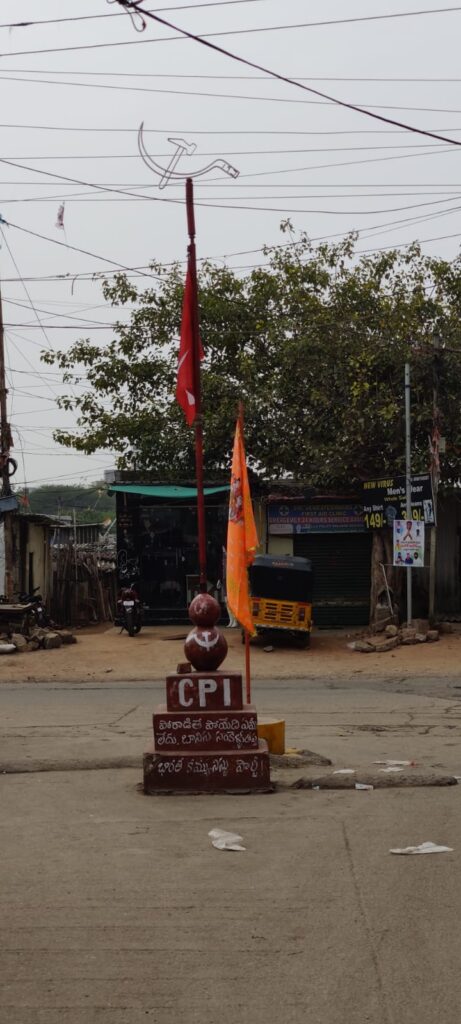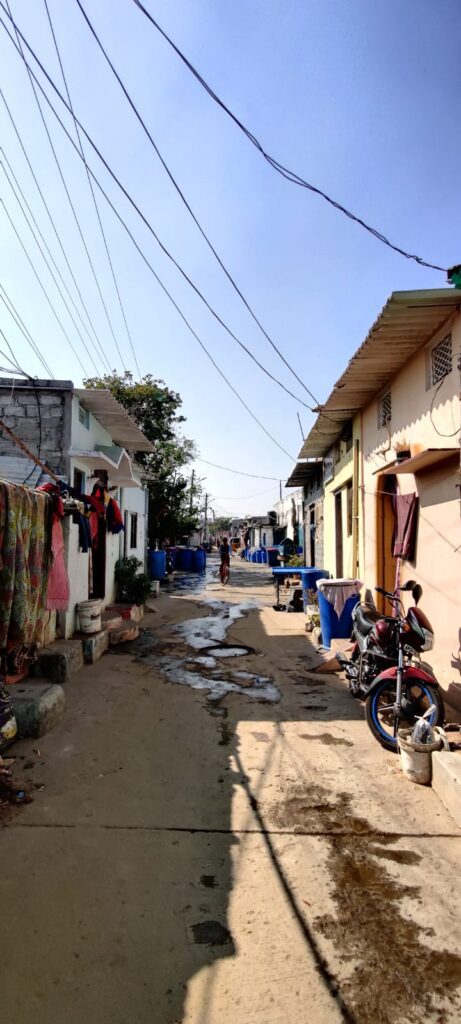Contributors: Rahul Mishra, Goutham Raj Konda, Tanaya Bhowal

Walking into Singareni on a warm sunny day, the sight of children playing, women collecting water from the water tanker, streets filled with spilt water from the water tanker, haphazardly hanging electric wires, some parked two wheelers, clothes hanging outside for drying are just come scenes which greet the eye. Singareni Colony is a neighbourhood situated in Saroornagar, Hyderabad. It is located towards the south of Hyderabad and is adjacent to the Saroornagar Lake. While there exist multiple entry points into the settlement, the colony itself isn’t well connected to the public transport options available to its immediate neighbour- Saroornagar. Saroornagar is connected to other parts of the city by public transport such as buses and the Metro, but these are not easily accessible to the residents of Singareni Colony. The colony is marked by narrow lanes, and tightly packed residential units. In terms of housing, the area is basically a patchwork of 3 kinds of residential units- hutments, government housing blocks and older middle class housing units of different housing societies. Team Cool Infrastructure’s research and fieldwork spanned across the first two categories of housing, that is, the hutments and the government housing.
HOW DID SINGARENI COME TO BE?
SPATIAL HISTORY AND DEVELOPMENT TRAJECTORIES OF SINGARENI
Singareni Colony has a tumultuous history of development, with land ownership being an ever contentious matter. Ownership of land or the lack of it by various groups has had several implications for the way the colony has grown over the years. Size of plots, building materials, negotiations for basic services like water and electricity have all evolved due to these various contestations over land throughout the past 30-40 years.
1980s- 1990s
During the early 1980s under the leadership of Nandamuri Taraka Rama Rao (of the Telugu Desam Party) Government Order No. 136 was passed which allowed land owners to sell their surplus land in line with the Urban Land Ceiling and Regulation Act (ULCRA) 1976. Landowners could now sell their lands to any registered government employee’s housing societies. Three housing societies bought land from private land owners to build middle class housing for government employees. These were- Singareni Collieries Officers Cooperative House Building Society (from hereon: Singareni Collieries Housing Society), the erstwhile unified Andhra Pradesh state’s Industries Department Employees House Building Co-operative Society (IDEHBCS), and Roudri Cooperative Housing Society (RCHS). The Industries Department Employees House Building Co-operative Society (IDEHBCS) bought 25 acres of land from 4 pattedars (land owners) to build a housing colony with 300 plots ranging between 200-265 sq. yards each. This land could not be registered under the name of IDEHBCS due to ULCRA restrictions. Approximately only 50 of the envisioned 300 plots were developed. Because of ULCRA restrictions, members were also unable to get housing loans. Roudri Cooperative Housing Society bought 25 acres of land from 6 individuals of which 3 were private land owners and 3 were protected tenants. Government allotted 70 acres of land to the Singareni CollieriesHousing Society. For the purpose of construction of these housing units, the Saroornagar Lake/tank was declared as abandoned in 1985. Following this, during the period between 1985 to 1989, 22 acres of the Singareni CollieriesHousing Society which overlapped the Saroornagar lake area was submerged
2000- 2010

Starting from the early 2000s, through proactive measures by the Communist Party of India, poor households started occupying vacant land in the Singareni Collieries Housing Board’s land parcels as well as those of RCHS. Yashoda, a long time resident of Singareni Colony testifies that she came to know of available land in the neighbourhood for poor people to occupy for free and moved there in April 2000. Similarly, many others occupied land and started constructing tenements. As people started pouring in, the settlement grew but didn’t have an identifying marker. It lacked a name. The neighbouring Singareni Officers Colony was already a landmark colony in the area and hence the name, Singareni Colony, was taken thereafter by the occupants.
The high influx of people coming to Singareni Colony to occupy whatever possible amount of land created a high density residential area. However, it became difficult for many to survive in Singareni Colony due to extremely small plot sizes, unaffordable private water supply and the lack of access to water from municipal or any government body. Therefore, people started leaving their occupied plots or half-built housing in Singareni Colony to go somewhere else in the city. Some sold their occupied plots with or without self-built tenements while others just left their plots which others proceeded to occupy. Though negligible (as it hardly ever led to accumulating close to even 80-100 sq. yards), this phenomenon eventually increased the plot size at the household level among the occupants of Singareni Colony. In 2002, RCHS approached the High Court of Andhra Pradesh seeking a writ of mandamus against the revenue authorities to take appropriate action to protect the land of the Society. Shortly after this, an interim order was passed by the High Court directing the Revenue Authorities to evict the encroachers. Subsequently in 2004, the High Court passed a judgement with respect to the submerged land belonging to Singareni CollieriesHousing Society and upheld the rights of the society and its member to title and interest in the land and permitted construction in the areas released from submergence as and when it happened.
One significant incident which set in motion a range of actions by those settled in Singareni and by the government was a huge fire accident in 2005. The fire accident with no officially established cause, did not result in any loss of life but only damaged property. This led the government to announce the construction of housing units under the Valmiki Ambedkar Awas Yojana (VAMBAY). VAMBAY was launched in 2001 to provide dwelling units and community toilet facilities to urban slum dwellers living below the poverty line. The Revenue Department, Office of District Collector, Hyderabad notified Singareni CollieriesHousing Society regarding the accommodation of the hut dwellers on the society land either by 30/06/2005 or before the construction whichever is earlier. The government proceeded with construction but was met with resistance. Under VAMBAY Scheme a total of 3024 housing units were sanctioned, but when IDEHBCS filed a case against the government on construction of these units, the High Court ordered stay on the construction, resulting in the completion of only 1792 units.

While the construction of these 1792 units was completed and people started residing in these units, negotiations between the housing societies, the people of the slum, and the government were ongoing for most of the decade and even post that. Court cases for evictions of the hutments are still in progress, making land tenure very dicey for the residents of the colony who are perpetually wary of their precarious conditions of living and working.
Credits: Swastik Harish
SINGARENI TODAY : DEMOGRAPHICS, SOCIAL CHARACTERISTICS, AND BUILT ENVIRONMENT
DEMOGRAPHIC COMPOSITION
A pilot household survey1 was carried out in Singareni to understand the demography of the neighbourhood in August 2022 where 185 households were surveyed. The caste composition of the households consists primarily of Other Backward Classes, Schedule Castes, and Schedule Tribes. There are temples, churches, and mosques within the colony with 74.45% of the households being Hindu, 19% being Muslim, and approximately 4.9% being Christian. Coming to the occupation status of those in Singareni, majority of the household heads are drivers of autos, and cars. Other main occupations include working as daily wage labourers, providing services such as plumbing, shopkeeping, and service technicians such as mechanics, mobile repair, and contractors. 37.2% of spouses of the household heads were housewives. Following this, 14.2% were daily wage labourers and cooks/domestic workers. Other occupations of women include sanitation and cleaning (inclusive of those working in schools, small eating joints/tiffin centres, hospitals and Greater Hyderabad Municipal Corporation sanitation workers) street vending, ragpicking, and ginger-garlic peeling. 41 of the 185 households had all identity documents, that is Aadhar Card, Voter ID, Caste Certificate, and Ration Card. Of the surveyed households, 9 were female headed households and the rest were male headed.
SOCIAL CHARACTERISTICS
In terms of education, there exist a few NGOs working in Singareni for providing education related services such as tuition for children and adolescents. Mana Trust, MV Foundation, Savitribai Phule Learning Centre, Ekalavya Foundation and Prajwala Learning Centre operate in Singareni colony to provide tuition and assist children in learning and educational assistance. As part of the Integrated Child Development Scheme, there exist 9 Anganwadis or day care centres for children below the age of 3 years. There also exist two government schools for children up to class 5 within the colony. Students also attend private schools and higher secondary schools in other nearby neighbourhoods. Coming to the socio-economic conditions of the colony, there exists widespread alcohol and drug abuse among men. There also exists high levels of domestic and sexual violence against women and girl children. While there is no direct established relation between these two, the high incidence of alcohol consumption and circulation among men is suspected to be one of the prime reasons for the violence against women.
BUILT ENVIRONMENT
Housing units in the colony are primarily constructed using materials such as asbestos, tarpaulin, fly ash, and to a lesser extent, concrete. These are used either in isolation or as a combination of two for building roofs and walls. Houses owing to their size and other security concerns either do not have windows or have windows which residents never open. Apart from security concerns, another reason for households keeping their windows shut is the garbage and sewerage stench (especially in the VAMBAY government housing quarters). Lack of windows/having closed windows severely restricts ventilation for these houses, making heat unbearable in the summers. While some houses open directly onto the street others have threshold spaces which are used for a variety of purposes such as washing clothes and utensils, area to sit and chat with neighbours, or otherwise just to store water or park two wheelers. Infrastructure problems in Singareni involve lack of basic services such as water supply, sanitation, and electricity. Residents tap into electricity connections of the government whereas for water, they rely on private water tankers. When one walks into Singareni Colony today, the sight of large blue drums holding water definitely stands out. The problem of waste disposal and collection is a big one. There are undesignated garbage points across the colony but mainly in the VAMBAY government housing units. Drainage and sanitation systems are also largely defunct. This causes unsafe conditions especially for girls and women to defecate while also being a public health concern.
On the bright side, the colony also has interesting vegetation in the forms of household plants and some trees in open areas. Plants such as Basil, Aloe Vera, and Tulasi among others are some of the most common plants. Products from such plants are useful for households to deal with heat in different manners and various recipes. Shade from trees and some extended portions of roofs forms an important aspect of everyday life to deal with extreme heat. In this way, vegetation and open and semi open spaces (such as threshold spaces) provide unique manners of coping with heat.


- The pilot survey was carried out by a group of Masters of Social Work students from Osmania University in association with Hyderabad Urban Lab. ↩︎
